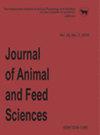Effect of caffeine on adenosine and ryanodine receptor gene expression in the hypothalamus, pituitary, and choroid plexus in ewes under basal and LPS challenge conditions
IF 1.5
4区 农林科学
Q3 AGRICULTURE, DAIRY & ANIMAL SCIENCE
引用次数: 3
Abstract
. Caffeine is a plant alkaloid that stimulates the central nervous system. It easily crosses the blood-brain barrier located in the endothelial cells of brain microvessels and the blood-cerebrospinal fluid barrier located in the epithelial cells of the choroid plexus (ChP). Caffeine exerts most of its biological effects by antagonising adenosine receptors (ADORs), but is also an agonist of ryanodine receptors (RYRs). A recent study in a sheep model has suggested that the effect of caffeine on the expression of many genes may depend on the animal’s immune status. Therefore, the aim of the study was to determine the effect of caffeine administration (iv, 30 mg/kg) in ewes, under basal and acute inflammatory conditions induced by lipopolysaccharide injection (iv, 400 ng/kg), on the expression of ADOR and RYR genes in the mediobasal hypothalamus (MBH), anterior pituitary (AP), and ChP. Our study showed that among caffeine-interacting receptors, ADORA1 was the most highly expressed in the AP and ChP, while ADORA3 in the MBH. Caffeine reduced ( P < 0.05) the inhibitory effect of inflammation on ADORA1 , but only in the MBH, and decreased ( P < 0.05) the stimulatory effect of endotoxin treatment on ADORA2B in the MBH and ChP. In contrast to ADORs , the expression of RYRs was less sensitive to the effects of inflammation and caffeine. We showed that caffeine influenced the expression of its receptor genes in the brain, but this effect seemed to be tissue-dependent and could be affected by the immune status of the animals. However, the physiological implications of these results require further detailed studies咖啡因对基础和LPS激发条件下母羊下丘脑、垂体和脉络丛腺苷和赖氨酸受体基因表达的影响
. 咖啡因是一种植物生物碱,能刺激中枢神经系统。它很容易穿过位于脑微血管内皮细胞的血脑屏障和位于脉络膜丛(ChP)上皮细胞的血脑脊液屏障。咖啡因通过拮抗腺苷受体(ADORs)发挥其大部分生物学作用,但也是一种ryanodine受体(RYRs)的激动剂。最近一项对绵羊模型的研究表明,咖啡因对许多基因表达的影响可能取决于动物的免疫状态。因此,本研究的目的是确定在脂多糖注射(iv, 400 ng/kg)诱导的基础和急性炎症条件下,母羊给予咖啡因(iv, 30 mg/kg)对下丘脑中基底部(MBH)、垂体前叶(AP)和ChP中ADOR和RYR基因表达的影响。我们的研究表明,在咖啡因相互作用受体中,ADORA1在AP和ChP中表达量最高,而ADORA3在MBH中表达量最高。咖啡因降低了炎症对ADORA1的抑制作用(P < 0.05),但仅在MBH中,降低了内毒素处理对MBH和ChP中ADORA2B的刺激作用(P < 0.05)。与ADORs相比,RYRs的表达对炎症和咖啡因的影响不太敏感。我们发现咖啡因影响了大脑中受体基因的表达,但这种影响似乎是组织依赖的,可能受到动物免疫状态的影响。然而,这些结果的生理意义需要进一步的详细研究
本文章由计算机程序翻译,如有差异,请以英文原文为准。
求助全文
约1分钟内获得全文
求助全文
来源期刊

Journal of Animal and Feed Sciences
农林科学-奶制品与动物科学
CiteScore
2.10
自引率
0.00%
发文量
42
审稿时长
3 months
期刊介绍:
Journal of Animal and Feed Sciences (JAFS, J. Anim. Feed Sci.) has been published by the Kielanowski Institute of Animal Physiology and Nutrition, Polish Academy of Sciences in Jabłonna (Poland) since 1991. It is a continuation of the Polish-language journal Roczniki Nauk Rolniczych. Seria B, Zootechniczna published by the Polish Academy of Sciences since 1969.
JAFS is an international scientific journal published quarterly, about 40 papers per year including original papers, short communications and occasionally reviews. All papers are peer-reviewed and related to basic and applied researches in the field of animal breeding and genetics, physiology of nutrition, animal feeding, feed technology and food preservation. The journal distinguishes the multidisciplinary nature of physiological and nutritional sciences and so includes papers specialized in all fields connected with animal well-being, including molecular and cell biology and the emerging area of genetics.
 求助内容:
求助内容: 应助结果提醒方式:
应助结果提醒方式:


